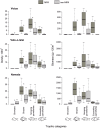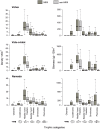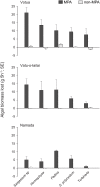Small Marine Protected Areas in Fiji Provide Refuge for Reef Fish Assemblages, Feeding Groups, and Corals
- PMID: 28122006
- PMCID: PMC5266309
- DOI: 10.1371/journal.pone.0170638
Small Marine Protected Areas in Fiji Provide Refuge for Reef Fish Assemblages, Feeding Groups, and Corals
Abstract
The establishment of no-take marine protected areas (MPAs) on coral reefs is a common management strategy for conserving the diversity, abundance, and biomass of reef organisms. Generally, well-managed and enforced MPAs can increase or maintain the diversity and function of the enclosed coral reef, with some of the benefits extending to adjacent non-protected reefs. A fundamental question in coral reef conservation is whether these benefits arise within small MPAs (<1 km2), because larval input of reef organisms is largely decoupled from local adult reproduction. We examined the structure of fish assemblages, composition of fish feeding groups, benthic cover, and key ecosystem processes (grazing, macroalgal browsing, and coral replenishment) in three small (0.5-0.8 km2) no-take MPAs and adjacent areas where fisheries are allowed (non-MPAs) on coral reefs in Fiji. The MPAs exhibited greater species richness, density, and biomass of fishes than non-MPAs. Furthermore, MPAs contained a greater abundance and biomass of grazing herbivores and piscivores as well as a greater abundance of cleaners than fished areas. We also found differences in fish associations when foraging, with feeding groups being generally more diverse and having greater biomass within MPAs than adjacent non-MPAs. Grazing by parrotfishes was 3-6 times greater, and macroalgal browsing was 3-5 times greater in MPAs than in non-MPAs. On average, MPAs had 260-280% as much coral cover and only 5-25% as much macroalgal cover as their paired non-MPA sites. Finally, two of the three MPAs had three-fold more coral recruits than adjacent non-MPAs. The results of this study indicate that small MPAs benefit not only populations of reef fishes, but also enhance ecosystem processes that are critical to reef resilience within the MPAs.
Conflict of interest statement
The authors have declared that no competing interests exist.
Figures







Similar articles
-
Community- and government-managed marine protected areas increase fish size, biomass and potential value.PLoS One. 2017 Aug 14;12(8):e0182342. doi: 10.1371/journal.pone.0182342. eCollection 2017. PLoS One. 2017. PMID: 28806740 Free PMC article.
-
Starting point or solution? Community-based marine protected areas in the Philippines.J Environ Manage. 2002 Dec;66(4):441-54. doi: 10.1006/jema.2002.0595. J Environ Manage. 2002. PMID: 12503498
-
A global analysis of the effectiveness of marine protected areas in preventing coral loss.PLoS One. 2010 Feb 17;5(2):e9278. doi: 10.1371/journal.pone.0009278. PLoS One. 2010. PMID: 20174644 Free PMC article.
-
Interactions between coral restoration and fish assemblages: implications for reef management.J Fish Biol. 2020 Sep;97(3):633-655. doi: 10.1111/jfb.14440. Epub 2020 Jul 20. J Fish Biol. 2020. PMID: 32564370 Review.
-
Climate Change, Coral Loss, and the Curious Case of the Parrotfish Paradigm: Why Don't Marine Protected Areas Improve Reef Resilience?Ann Rev Mar Sci. 2019 Jan 3;11:307-334. doi: 10.1146/annurev-marine-010318-095300. Ann Rev Mar Sci. 2019. PMID: 30606097 Review.
Cited by
-
Network of small no-take marine reserves reveals greater abundance and body size of fisheries target species.PLoS One. 2019 Jan 10;14(1):e0204970. doi: 10.1371/journal.pone.0204970. eCollection 2019. PLoS One. 2019. PMID: 30629577 Free PMC article.
-
Protecting nursery areas without fisheries management is not enough to conserve the most endangered parrotfish of the Atlantic Ocean.Sci Rep. 2020 Nov 12;10(1):19143. doi: 10.1038/s41598-020-76207-x. Sci Rep. 2020. PMID: 33184332 Free PMC article.
-
Size matters: Predator outbreaks threaten foundation species in small Marine Protected Areas.PLoS One. 2017 Feb 6;12(2):e0171569. doi: 10.1371/journal.pone.0171569. eCollection 2017. PLoS One. 2017. PMID: 28166257 Free PMC article.
-
Linking small-scale fisheries co-management to U.N. Sustainable Development Goals.Conserv Biol. 2022 Dec;36(6):e13977. doi: 10.1111/cobi.13977. Epub 2022 Oct 19. Conserv Biol. 2022. PMID: 35866368 Free PMC article.
-
A contemporary baseline of Madagascar's coral assemblages: Reefs with high coral diversity, abundance, and function associated with marine protected areas.PLoS One. 2022 Oct 20;17(10):e0275017. doi: 10.1371/journal.pone.0275017. eCollection 2022. PLoS One. 2022. PMID: 36264983 Free PMC article.
References
-
- Bellwood DR, Hoey AS, Choat JH. Limited functional redundancy in high diversity systems: resilience and ecosystem function on coral reefs. Ecol. Lett. 2003;6:281–5.
MeSH terms
Grants and funding
LinkOut - more resources
Full Text Sources
Other Literature Sources

